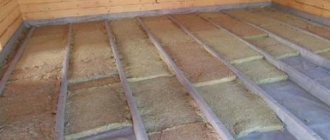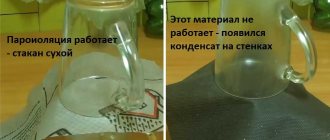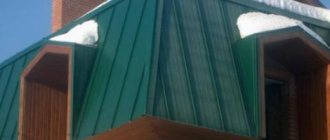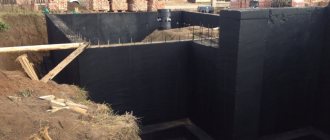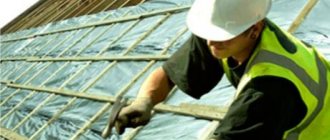External differences between vapor barrier and waterproofing
What is the external difference between waterproofing and vapor barrier? This question can be answered by analyzing the structure of both materials.
Structure of vapor barrier films
Installation of vapor barrier is carried out from the inside of the roof
Before purchasing any film, be sure to make sure that it is a vapor barrier, as indicated by the inscription on the packaging.
Structure and types of waterproofing films
It may well seem to an amateur that if the vapor barrier is completely waterproof, then it may well serve as a replacement for the waterproofing layer. One can assume, even out of ignorance, that vapor barrier is better than waterproofing, which is fundamentally wrong.
Both vapor barrier and waterproofing film materials serve strictly to achieve a specific purpose, and if you replace one with the other, this can lead to unpredictable consequences and additional monetary costs.
The main functions of waterproofing are as follows:
- protection from external moisture entering the insulation layer;
- removing accidentally trapped water vapor from the insulation.
Waterproofing polymer films have a number of useful properties:
- resistance to ultraviolet radiation;
- resistance to temperature fluctuations;
- high strength characteristics.
Based on the type of porous structure, membrane films can be:
- diffusion;
- superdiffusive.
Superdiffusion membranes significantly exceed diffusion films in terms of vapor removal, and there is no need to create a ventilation gap between the waterproofing and the insulation.
The organization of a ventilation gap between the roofing covering and the membrane is mandatory in any case in order to allow water vapor to escape with the air flow into the atmosphere.
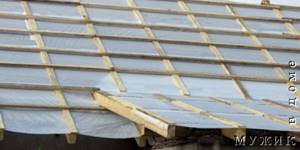
Waterproofing is laid over the roof insulation
Selection of films for waterproofing
- The waterproofing layer should be made of special films, which are called membrane films. They are characterized by increased strength and resistance to sudden temperature changes. The porosity of the structure allows steam to escape freely, while moisture cannot penetrate inside.
- Not all types of roofing allow the use of membrane films. In some cases, it is advisable to opt for the anti-condensation option. The difference is that these films accumulate escaping steam on the fleecy surface, which is removed by air from the ventilation gap. This ensures dryness and heat retention in the house.
Types of vapor barrier materials
Films made of polyethylene and polypropylene

It is not practical to use ordinary polyethylene films for vapor barrier of steam rooms: they quickly lose their properties at high temperatures, but they can be used in washing rooms or changing rooms/dressing rooms.
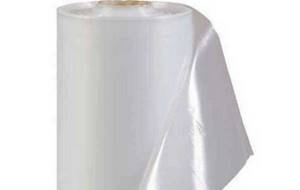
Vapor barrier: polypropylene film
Membranes
As a rule, a two-layer polypropylene vapor barrier is mounted on the inside of the insulation with the smooth side close to the insulation. For example, if a vapor barrier is installed in the attic of a bathhouse, then the rough side should be at the bottom.
Double-sided membranes can be laid on either side - they operate in both directions.

Vapor barrier: diffuse membranes
Foil materials

Foil vapor barrier on the ceiling and walls of the steam room
There are several types of such materials:
Cheap vapor barrier for baths
Liquid (coating) vapor barrier

Vapor barrier: liquid rubber
Bath lovers and experts recommend using only foil roll materials for vapor barrier of the ceiling and walls of the steam room, which not only serve as a vapor barrier, but also reflect thermal radiation inside, reducing the cost of maintaining the temperature.
Features of roof vapor barrier depending on the device and the nature of its operation
There are three types of roofs:
- uninsulated; insulated; combined.
The first type does not require roof vapor barrier. Only the ceiling is insulated, so the vapor barrier is laid on the surface of the “rough” ceiling of the upper floor on the side of the heated room.
Vapor barrier of a cold attic is carried out in any case, regardless of the floor materials
If the cold roof is not covered with a metal roof, then in some cases you can even do without waterproofing. For example, when using slate or ondulin, which has a rough (fibrous) texture - a kind of anti-condensation surface.
Insulated roofs, the internal volume of which is completely occupied by attics or occupied attics with engineering equipment, have a “continuous” roof vapor barrier device. That is, a vapor-proof film is installed from below the insulation along the rafters in a continuous and continuous layer over the entire inner surface of the roof.
If the “height” of the rafter section is not sufficient to accommodate mineral wool of the calculated thickness, a counter-lattice is installed from the inside, between which an additional layer of insulation is laid. In this case, the vapor barrier is attached to the counter-lattice.
If there is an additional layer of roof insulation, a vapor barrier is attached to its sheathing
Combined roofs have a dedicated “warm” contour. It can take different forms:
Cut off any part of the attic at a vertical level from the side of the slope or gable. In this case, the walls of such an attic space are insulated according to the principle of a frame house. And the vapor-proof film of the walls is overlapped and hermetically sealed with tape to the vapor barrier of the roof in its insulated part.
Cut off part of the attic along the horizon. In this case, the attic has “its own” cold attic, which is insulated along its ceiling. And the vapor barrier is sewn from below to its ceiling (or false ceiling) and connected with tape to the vapor-proof film of the insulated part of the slope.
Vapor barrier of the attic roof is carried out along the insulation contour
This may be interesting! In the article at the following link, read about a country house made of SIP panels - comfort and coziness at an affordable price.
The gables of houses with a gable or multi-gable roof are insulated in the same way as the facade.
How to attach a vapor barrier
The choice of fastening method depends on the type of vapor barrier material used. Polyethylene and polypropylene films are secured with small nails or with staples and a construction stapler.
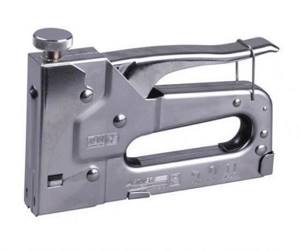
Construction stapler (mechanical)
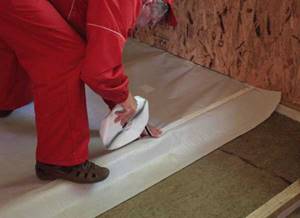
Attaching the vapor barrier
The sheets of rolled materials are laid one on top of the other with an overlap of at least 10-15 cm, gluing the joints with adhesive tape. You can use specialized, foil or regular adhesive tape.

Double-sided adhesive tape UNIBOB based on cotton fabric. An adhesive layer based on synthetic rubber, which ensures high quality gluing of vapor-waterproofing sheets
Vapor barrier and waterproofing: what is the difference, features of the use of materials
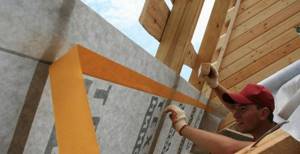
If your roof suddenly begins to drip, the first thing you will most likely decide to do is check the integrity of the roof covering; if it turns out to be undamaged, most likely the vapor barrier and waterproofing were mixed up during construction. Moisture from the air in the house is collected in the insulation and when it gets colder it condenses. If such a situation has already occurred, then the insulation will have to be replaced, in order to avoid such a situation in the future, let's figure out what vapor barrier and waterproofing are, what are their differences and features.
Vapor barrier: what is it for, installation features
The vapor barrier is attached from the inside of the roofing pie; it is designed to prevent moisture from entering the insulation. Vapor barrier films are absolutely moisture-proof; the simplest example of a vapor barrier film is ordinary polyethylene film, which is often used to cover plantings in the garden. However, it is extremely ineffective from the point of view of using vapor barrier material inside the house, since due to its low density, polyethylene will quickly stretch and lose its tightness. A good example of a vapor barrier can be considered a film consisting of several layers with a reinforcing frame; if there is another layer of foil on such a film, you will not only isolate the insulation from steam and moisture, but also retain more heat inside the house. Vapor barrier films are usually produced rolled into a roll 1.5 m wide and from half a meter to a meter long. The joints of the films are usually glued with a special glue (primer) or tape.
Distinctive features
:
- smooth or ribbed;
- does not allow any moisture to pass through;
- attached from the inside of the roofing pie;

Waterproofing: distinctive features
Waterproofing is used on the outside of the roofing pie. The waterproofing film reliably protects the insulation from moisture and the influence of the external environment, however, unlike vapor barrier, this film contains micropores. What are they for? It turns out that there is still no film in the world that is 100% vapor-proof; some of the steam will still seep into the insulation, and the tightness of the vapor barrier layer may break over time. Through these pores, moisture from the insulation can escape. It is especially important when installing waterproofing to lay it correctly: the pores in this film resemble a funnel; if installed correctly, a drop of water cannot pass through the narrow neck of the pore, and a steam molecule freely leaves the insulation through the wider part of the “funnel”.
Where else, besides the roof, is vapor barrier and waterproofing useful?
However, waterproofing and vapor barrier are needed not only in the roof pie. These materials are needed wherever materials are adjacent to moisture. Waterproofing is essential for foundations, floors and bathrooms where humidity tends to be high. Vapor barrier is necessary in almost every room, even between the floors of the first and second floors, since steam rises upward and can gradually destroy the floors.
Vapor barrier manufacturers
There is a large selection of vapor barriers on the market today from different manufacturers. A decent share of the market is occupied by Izospan materials (Gexa company). Today the following types of products are produced:
By the way! It will be interesting to know: Features of laying floor vapor barrier
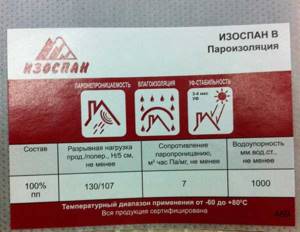
Materials for vapor barrier: Izospan B
There are a number of other companies with good reviews:
- trademark Delta company Dorken (Germany)
- Yutafol, Yutavek produced by Juta (Czech Republic)
- Klober (Germany)
- Tyvek films DuPont (USA)
- Fakro (Poland)
Vapor control materials on the market
Hydro- and vapor barrier films Grand Line®
The line includes hydro- and vapor barrier films and superdiffusion membranes. Grand Line H98 film has a number of advantages - the laying pattern, installation side, and overlap boundaries are indicated on the roll. Made from primary raw materials.

Roof vapor barrier Folder
Folder products offer several types of material:
- Folder Steam Regulator - this material can provide controlled vapor transmission, maintain the level of vapor barrier and allow excess moisture to pass through as much as possible.
- Alum H90 is a reinforced film with a foil layer that allows you to retain heat in the room and at the same time remove excess moisture.
- H98 – has a laminated layer, can be used with any thermal insulation material.

Hydro- and vapor barrier Tyvek®
The Tyvek line includes two vapor barrier membranes:
- Tyvek® AirGuard® Reflective – completely airtight. This membrane was developed to provide more efficient thermal insulation performance. The possibility of condensation entering is minimal.
- Tyvek® AirGuard® SD5 is a material with limited vapor permeability, thereby reducing the risk of condensation and condensation.

Delta insulation materials
- DELTA-DAWI GP is a simple single-layer polyethylene film.
- DELTA-NEOVAP 20 is a film with a reinforcing layer, due to which the risk of damaging the vapor barrier becomes much lower.
- DELTA®-REFLEX PLUS / DELTA®-REFLEX is a film with almost zero vapor permeability. This ensures that condensation does not get on the thermal insulation. This material also reflects heat back into the room.
Insulation from Icopal Fel'X
Icopal Fel'X insulation is a material consisting of three layers - polypropylene, SBS-modified bitumen and a non-woven base. These layers provide strength, waterproofing and protection to the roofing pie.
Hydro- and vapor barrier for roofing Izospan
The assortment includes several products:
- Izospan FS - consists of non-woven dense and metallized polypropylene film. Protects the structure from steam and also reflects heat into the building.
- Izospan B has two layers, the first layer is smooth, the second is rough, capable of holding condensation.
- Izospan D is a membrane that is a two-layer material. Performs the functions of hydro- and vapor barrier. The material is very durable and has high UV stability.
- Izospan DM - this material combines the functions of wind protection, waterproofing and vapor barrier. Consists of three layers.
Hydro- and vapor barrier Optima
One of the economical materials. The line includes Optima B - vapor barrier, Optima C - provides vapor and waterproofing, and Optima D - a universal hydro- and vapor barrier material with increased strength.
Waterproofing TechnoNIKOL
A three-layer membrane has high vapor permeability, quickly removes moisture and protects the insulation.
Hydro- and vapor barrier Ondutis
It is a fabric with the addition of a UV stabilizer and a protective layer.
- Ondutis V (R70) Smart is a classic film. Performs all necessary functions, protects the insulation and removes moisture.
- Ondutis D (RV) Smart - this film can be used as a vapor barrier on a warm roof and as a waterproofing on a cold roof.
What is a vapor barrier?
Before considering the differences between vapor barrier and waterproofing, it is necessary to clearly define both materials.
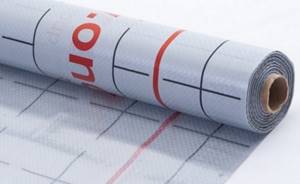
Vapor barriers are special materials that provide reliable protection of mineral insulation and building structures from the effects of water vapor.
Application area
Increasing the energy efficiency of buildings and reducing energy costs are directly related to the presence of a thermal insulation layer. Wherever thermal insulation materials are used, a vapor barrier is required. This is especially true for:
Thus, almost all key elements of the building require vapor barrier.
Materials
On the construction market, vapor barrier materials are presented in a wide range. They may differ in cost, performance characteristics and service life. The most common vapor barriers include:
There are other types of vapor barriers that are less widespread. These include liquid rubber and polymer burlap.
External differences in structure
What is the difference between vapor barrier and waterproofing is described below.
Vapor-permeable materials may have the following differences from vapor barrier films:
- They are porous or have a fibrous structure.
- Sometimes such materials have several layers.
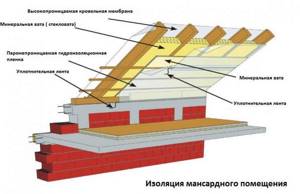
Vapor-tight materials are dense and smooth in appearance.
It must be remembered that waterproofing must allow steam to pass freely. The vapor barrier does not allow water or steam to pass through.
Floor waterproofing - what types exist?
There are three types of floor insulation before installing the screed. They differ in technology and materials:
- Coating – oxidized bitumen, which contains organic and inorganic additives, such as: latex;
- plasticizers;
- rubber crumb.
This material is manufactured in such a composition to increase fluidity when applied to the coating. After complete hardening, the waterproofing covers the surface with an elastic and durable film that does not allow water to pass through.
Liquid glass, bitumen and polymer mastics are coating materials with high adhesion.
Coating waterproofing not only provides good protection for floors and slabs, but also serves as a reinforcing frame for the screed.
- Pasting - using materials in rolls. The waterproofing composition consists of polymers, fiberglass and reinforcement. Recently, manufacturers have begun to produce self-adhesive roll materials.
It is worth noting that in this situation, for better adhesion of the composition to the concrete, a burner is used to heat the insulation.
- Combined, used if there is high humidity in the room, kitchens, bathrooms. Such floor waterproofing for heated floors perfectly protects the floors, and accordingly your neighbors below, from moisture.
It is planned to use materials of the first and second types of insulation, which are produced in several layers.
Insulating materials
There are many varieties of materials. The area of use and properties are different, so before purchasing you need to read the manufacturer's manual.
Roll materials are:
- Hydroisol;
- Rubiroid;
- Isoplast;
- Filizol.
Sold in rolls, the material is very durable and not afraid of mechanical stress.
This material can be used on any type of floor. The advantage of roll insulation is its ease of use and low cost.
Experts do not recommend using roofing felt for waterproofing bathrooms, toilets and kitchens.
There are two ways to attach roll insulation:
- for bitumen or polymer mastic;
- heating the material with an open flame using a burner.
Paint insulation
This name is used because such waterproofing is applied under a warm floor by applying it to the surface with a brush or roller. It has two application methods - hot and cold.
For example, liquid glass is applied coldly and hardens when exposed to air; this is facilitated by special hardeners added to the composition.
All bitumen-based liquid waterproofing requires pre-heating to a fluid state. Bitumen is applied to the surface and, when cooled, creates a waterproof film.
When treating the floor with insulating mixtures, it is worth coating the adjacent walls to a height of 30 cm. This is especially true for wet rooms.
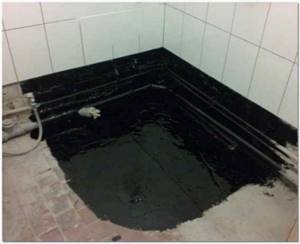
Self-leveling insulators
The material is quite in demand and easy to use, its only drawback is the cost. But thanks to this waterproofing, a monolithic surface is formed on the floor, completely insulated.
Application is quite simple: the mixture is diluted to the desired consistency, poured onto the floor and leveled with a special needle roller.
Having considered the types of waterproofing, you can begin to carry out work.
The nuances of laying roofing films
A ventilation gap is left between the coating and the thermal insulation. This eliminates the possibility of moisture retention, which is removed from the room. This rule is mandatory if a diffuse membrane is installed. The superdiffuse analogue does not require such a recommendation due to the large number of pores in the structure. The coating is used to protect roofing insulation from precipitation and steam.
Perforated film

The reliability of the roof can be increased by using micro-perforated or diffuse film for defense, which are essentially breathable membranes. With their help, the protection of the entire space between the rafters is used. Such membranes must be laid on a thermal insulation layer.
The vapor barrier layer involves the use of polymers - polyethylene and polypropylene. Polyethylene is based on a reinforced film with a mesh structure. Such material can be:
- standard (vapor permeable)
- with reflective layer
- with limited vapor permeability
- with variable vapor permeability.
Polypropylene is an aluminized or foil layer. This layer is responsible for sealing.
To understand this, you need to add a little theory.
Let me remind you that the purpose of this article is to explain “at a glance” what is happening, without delving into physical processes, partial pressure, molecular physics, etc. So I apologize in advance to those who got an A in physics? In addition, I’ll immediately make a reservation that in reality all the processes described below are much more complicated and have a lot of nuances. But the main thing for us is to understand the essence.
Nature has decreed that steam in a house always flows in the direction from warm to cold. Russia, a country with a cold climate, has an average heating period of 210-220 days out of 365 per year. If you add to it the days and nights when it’s colder outside than in the house, then even more.
Therefore, we can say that most of the time, the vector of steam movement is directed from inside the house, out. It doesn’t matter what we are talking about - walls, roofing or lower floors. Let's call all these things in one word - enclosing structures
In homogeneous structures, the problem usually does not arise. Because the vapor permeability of a homogeneous wall is the same. The steam easily passes through the wall and exits into the atmosphere. But as soon as we have a multilayer structure consisting of materials with different vapor permeability, everything becomes not so simple.
Moreover, if we talk about walls, then we are not necessarily talking about a frame wall. Any multi-layer wall, even brick or aerated concrete with external insulation, will make you think.
You've probably heard that in a multilayer structure, the vapor permeability of the layers should increase as the steam moves.
What will happen then? Steam enters the structure and moves through it from layer to layer. At the same time, the vapor permeability of each subsequent layer is higher and higher. That is, from each subsequent layer, steam will come out faster than from the previous one.
Thus, we do not form an area where the saturation of steam reaches the value when, at a certain temperature, it can condense into real moisture (dew point).
In this case, we will not have any problems. The difficulty is that achieving this in a real situation is not easy.
Fear has big eyes; in fact, with films in a wall or roof, everything is quite simple. The main thing to remember is to follow the following rules:
- In cold climates (most of Russia), vapor barrier is always installed only on the inner, “warm” side - be it a roof or a wall
- Vapor barrier is always done as tightly as possible - joints, openings of communication penetrations are taped. In this case, special adhesive tape is often required (usually with a butyl rubber adhesive base), since simple tape can come off over time.
- The most effective and cheapest vapor barrier is 200 micron polyethylene film. Preferably, the “primary” one is transparent; it is easiest to glue the joints on it with ordinary double-sided tape. Purchasing “branded” vapor barriers is usually unjustified.
- Vapor-permeable membranes (super-diffusion, windproof) are always installed on the outer, cold side of the structure.
- Before installing the membrane, pay attention to the instructions for it, since some types of membranes are recommended to be installed with a gap from the material to which it is adjacent.
- Instructions can be found on the manufacturer's website or on the roll of the film itself.
- Usually, in order to avoid mistakes with “which side” to mount the film, manufacturers roll the roll so that when “rolling” it from the outside along the structure, you will automatically mount it on the correct side. For other uses, before starting installation, think about which side to place the material on.
- When choosing a vapor-permeable membrane, you should give preference to high-quality ones - Tyvek, Tekton, Delta, Corotop, Juta, Eltete, etc. As a rule, these are European and American brands. Membranes - Izospan, Nanoizol, Megaizol and other “isols”, “brains”, etc. as a rule, they are much inferior in quality, and most of them are of unknown Chinese origin with the brand of a trading company stamped on the film.
- If you have any doubts about using the film, go to the manufacturer’s website and read the instructions or recommendations for use. Do not trust the advice of “sales consultants”. Refers mainly to “first and second echelon” materials. There are often a large number of errors in the instructions of third-tier manufacturers, since in fact they only sell films, without producing them or engaging in any development, so the instructions are written “on the knee”
PS If you are interested in a little more information about the differences in vapor-permeable waterproofing membranes, I recommend reading this short document
(Visited 121,928 times, 31 visits today)
Let's start with the roof. When building a house, this structural element is given paramount importance. Because it primarily resists the effects of various natural elements: heavy precipitation in the form of rain, snow, hail, hurricane gusts of wind (wind protection), and also protects the house from the scorching rays of the sun. Both materials have wind protection. The roof guards our comfort and convenience.
We invite you to familiarize yourself with: Do-it-yourself army tent

In addition to protecting against external influences, the roof also prevents heat from escaping from the house to the outside. After all, it is very well known that warm air currents always tend upward, so it is always necessary to install insulation on roofs in order to retain internal heat and prevent external cold from penetrating into the premises.
The materials themselves, from which the roof is constructed, of course, do not allow moisture to pass through and protect the insulation from getting wet, but they are not able to protect it from the effects of water vapor. To do this, it is necessary to carry out waterproofing measures that will protect the insulation from excess moisture.
Some builders, in order to save money or due to lack of knowledge, do not waterproof the insulation installed under the roof. Very often, cheap materials are purchased, and some even use ordinary plastic film for greenhouses, others prefer to use materials that protect only from steam, without betraying the fact that these are completely different products with different properties.
As a result, within a short period of time from installing the attic roof and insulation with improper waterproofing, water suddenly begins to drip, and the ceiling becomes covered with stains. In this case, most often the roofing surface is thoroughly checked for damage, but not finding any, many wonder what was done wrong.
The explanation in this case is quite simple: if instead of a waterproofing film a vapor barrier was installed, then as a result the insulation has completely absorbed moisture and creates streaks and “rain” in the room. It is much worse if waterproofing was not carried out at all, then in this case the insulation filled with moisture causes harm to the rafters, the wooden sheathing and even the entire roof structure, thereby damaging the interior decoration of the premises.
- protect the insulation from moisture penetration from the outside;
- remove any moisture that has entered the insulation.
The question arises: how can moisture get into the insulation if measures have been taken to protect it?
This is possible because the insulation is not completely sealed; moisture gets through the gaps intended for ventilation into the insulation from the room. And our goal is to remove it; for this we use a waterproofing film or membrane. It has the following properties:
- Resistance to UV examination.
- Resistant to temperature changes.
- High strength.
- Porous structure.
Let us dwell on this last and main quality of hers. Thanks to this structure, water vapor that gets into the insulation can escape from it. All over the surface of the film there are holes or pores that have a certain shape, in the form of a funnel, its wide part is directed inward towards the insulation, and the narrow part is directed outward, due to this, moisture from the external environment cannot penetrate into the insulation, since it has a large molecular size, steam, on the contrary, it can go out unhindered.
Therefore, when installing such membranes, it is very important not to confuse the corresponding sides, the one that will be directed towards the insulation and the other outward.
At this moment they differ in the number of pores. There are fewer of them on the diffuse one; when laying it on the insulation, a ventilation gap should be made, since mineral wool fibers can clog the pores of the film and lead to a decrease in its quality. The use of superdiffuse membranes does not provide for the creation of a ventilation gap.
It is worth remembering that when using any membranes, it is necessary to leave spaces between the roof and the membrane so that water vapor does not accumulate under the roof, but goes into the air space.
Waterproofing underfloor heating
Many people install heated floors in their apartments. In this situation, waterproofing of warm floor coverings is mandatory:
- apply a layer of insulation to the base;
- pour concrete screed;
- install a heated floor;
- pour a layer of self-leveling floor;
- install the final floor covering.
It is not recommended to use bitumen-based waterproofing under a heated floor, as the mastic will heat up under the influence of heat and release toxic fumes into the air.
The methods described above will help you wisely choose not only the right material for waterproofing, but also install it correctly.
By the way! It will be interesting to know: How to properly lay waterproofing on the floor
Waterproofing specialist. Worked for 30 years in a construction company. He writes excellent articles and answers your questions about waterproofing.
Vapor barrier films – 100% protection against steam penetration
Such products have a 100% waterproof surface on both sides that does not allow steam to pass through or release it. The most affordable option is simple plastic film, which is usually used by summer residents in their gardens. True, it can only be used for roofing as a last resort, since there is always a high temperature under the roof, under the influence of which the multilayer film can lose its properties. The best option is to use a multilayer film with a reinforcing polymer frame.
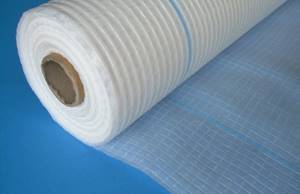
The presence of a frame will not allow the vapor barrier material to stretch, and many layers of film will ensure the longest possible service life. But the best and at the same time the most expensive type of material for roof vapor barrier can be called foil film. The foil part is laid inside the roof, which will reflect infrared radiation. This film will protect the insulation from steam penetration and increase the level of warm air retention, and you will save on heating in the winter.
What type of vapor barrier is there?
A vapor barrier is a material that does not conduct water vapor. There are two types:
- with one-way conductivity;
- vapor-tight.

Which side to lay the vapor barrier is important for membranes and materials with a shiny coating. There are also vapor barrier materials with a heat-reflecting effect. They can be distinguished by a shiny surface on one side (there are materials on both sides that reflect heat). A shiny surface can be:
- thin foil glued to the surface;
- metallized lavsan;
- metallized polypropylene.
Vapor barrier of roof and walls. Where is it installed and why is it needed?
Let's look at another situation. Steam has entered the structure and moves outward through the layers. I went through the first layer, the second... and then it turned out that the third layer was no longer as vapor-permeable as the previous one.
As a result, the steam that gets into the wall or roof does not have time to leave it, and a new “portion” is already supporting it from behind. As a result, before the third layer, the vapor concentration (more precisely, saturation) begins to increase.
Remember what I said before? Steam moves in a direction from warm to cold. Therefore, in the region of the third layer, when the steam saturation reaches a critical value, then at a certain temperature at this point, the steam will begin to condense into real water. That is, we got a “dew point” inside the wall. For example, at the border of the second and third layers.
There was an obstacle in the way of the steam. Steam saturation has increased and condensation is likely to form
This is exactly what people often observe when the outside of their house is covered with something that has poor vapor permeability, such as plywood or OSB or DSP, but there is no vapor barrier inside or it is made poorly. Rivers of condensation flow along the inside of the outer skin, and the cotton wool adjacent to it is all wet.
Steam easily enters the wall or roof and “slips through” the insulation, which usually has excellent vapor permeability. But then it “rests” on the outer material with poor permeation, and as a result, a dew point forms inside the wall, right in front of the obstacle to the steam path.
There are two ways out of this situation.
- It takes a long and painful time to select materials for the “pie” so that the dew point under no circumstances ends up inside the wall. The task is possible, but difficult, given that in reality, the processes are not as simple as I am describing now.
- Install a vapor barrier from the inside and make it as airtight as possible.
It is along the second path that they go in the west, making a hermetically sealed obstacle in the path of the steam. After all, if you don’t let steam into the wall at all, then it will never reach the saturation that will lead to condensation. And then you don’t have to rack your brains over what materials to use in the “pie” itself, from the point of view of the vapor permeability of the layers.
Moreover, the most popular material for this “they have” is ordinary polyethylene 200 microns. Which is inexpensive and has the highest resistance to vapor permeation, after aluminum foil. Foil would be even better, but it's hard to work with.
In addition, I pay special attention to the word hermetically sealed. In the west, when installing a vapor barrier, all joints of the film are carefully taped. All openings from communication wiring - pipes, wires through a vapor barrier - are also carefully sealed
The installation of overlapping vapor barriers, popular in Russia, without gluing the joints, can result in insufficient tightness and, as a result, you will get the same condensation.
The vapor barrier does not allow steam into the wall and, accordingly, the likelihood of getting enough steam for condensation is greatly reduced
Untaped joints and other potential holes in the vapor barrier can cause a wet wall or roof, even if there is a vapor barrier itself.
I would also like to note that the mode of operation of the house is important here. Summer country houses, in which you visit more or less regularly only from May to September, and maybe several times in the off-season, and the rest of the time the house is without heating, can forgive you some flaws in the vapor barrier.
But a house for permanent residence, with constant heating, does not forgive mistakes. The greater the difference between the external “minus” and the internal “plus” in the house, the more steam will flow into the external structures. And the greater the likelihood of getting condensation inside these structures. Moreover, the amount of condensate can ultimately amount to tens of liters.
Structure, properties and types of vapor-permeable waterproofing membranes
Film waterproofing membranes have many holes in the form of a sieve. They are made in the shape of a funnel, the smaller diameter of which does not allow a water molecule to pass through the hole.
The membrane, located on the outer surface, does not allow moisture to penetrate in the form of water, but is available for steam to escape from the inner surface of the insulation or cladding.
There are many types and brands of membrane waterproofing, but their main difference is the diameter of the funnel holes for steam. Superdiffusion waterproofing films have the smallest diameter.
To understand the essence of their work, it is important to know:
What are protective films needed for: waterproofing and vapor barrier
Insulating a house necessarily involves installing various protective layers for the insulation itself. These layers perform the functions:
- protection from direct moisture entering the insulating layer - waterproofing;
- a barrier against blowing through the structure and blowing out the insulation material - wind protection;
- a barrier against gaseous moisture entering the insulation - vapor barrier.
In real construction, films are divided into only two types:

Why do you need a vapor barrier?
The direction of steam movement is mainly from the warm room to the outside. This is especially typical for the Russian climate, when the outside air temperature is almost always below room temperature.
In traditional enclosing structures without the use of insulating materials - walls, roofs and ceilings - there are no problems with steam escape. Steam escapes freely through such structures into the atmosphere.
Difficulties with steam removal in multilayer structures
Difficulties arise in enclosing elements made of several layers with different vapor permeability parameters. Usually this is an insulated roof or walls of a frame house.
But not only frame elements can be considered multi-layered and heterogeneous, but also walls made of foam blocks insulated from the inside or outside, wooden buildings or brick walls with an insulating layer.
In order to uniformly and quickly remove steam from a room through several layers of various materials, the vapor permeability of the layers must constantly increase.
The steam should not encounter resistance in any of the layers: as soon as this happens, the movement of the steam stops, it gradually cools and falls out in the form of condensation inside the enclosing structure.
A dew point appears, the material inside the enclosing element is saturated with moisture, which, in turn, causes a destructive effect:
- black spots appearing on walls and ceilings from nowhere;
- water stains on the outer wall cladding;
- smell of mold in the house.
There are many examples where the cause of trouble is an improperly designed natural steam removal system.
By the way! It will be interesting to know: GLASS MASTER B Vapor barrier (70m2)
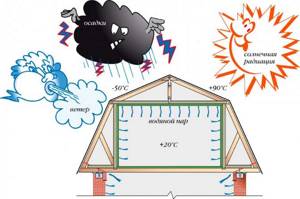
The need for a vapor barrier and its difference from waterproofing
To avoid difficulties with the selection of vapor-permeable layers, the tightness method is used, that is, a device for complete vapor barrier of the enclosing structural elements.
In this case, steam escapes from the premises using natural or forced ventilation. Wall or roof structures will always be protected from moisture in the form of steam, will always be dry, and will last a long time and reliably.
Vapor barrier does not have the properties of a membrane, that is, microscopic holes: this is the essence and main difference between vapor barrier materials and waterproofing materials.
How not to confuse insulating materials ↑
Vapor barrier films ↑
Such films have an absolutely waterproof surface on both sides, i.e. they do not let in any moisture and do not let out any. The cheapest version of such film is ordinary polyethylene, used in vegetable gardens. True, it can only be used for roofing as a last resort, because it is always hot under the roof, and the thin film is destroyed and stretched by the temperature. The best option is a multilayer film with a reinforcing frame made of polymers. The frame prevents it from stretching and sagging, and many layers ensure a long service life.
A more expensive, but very useful type of vapor barrier film is foil, i.e. on one side having a layer of foil. This film is placed with the foil side inside the roof to reflect infrared radiation, which causes the bulk of the heat to escape from the premises. By using such a film to insulate steam, you will automatically increase the level of heat retention, which means you will pay less for heating.
Waterproofing films ↑
The films described above are not suitable for waterproofing, because they are absolutely waterproof. They, of course, will not let moisture in from the outside, but this is not enough for the normal functioning of the roofing pie. The fact is that the waterproofing layer performs one more task: it removes accidentally trapped vapors from the insulation. The question may arise: where do they come from, if there is a film barrier inside and outside too. It turns out that there is no film in the world that is 100% waterproof. Some of the steam will still leak out of the premises or the ventilation layer, so you need to make sure that the moisture finds its way out. For this purpose, special waterproofing films called membranes were invented. They are made of polymers and are characterized by increased strength, resistance to temperature changes and ultraviolet radiation. But their most important property lies in their structure: it is porous. This is done so that steam can seep through the pores under the roof.
There are diffusion and superdiffusion membrane films. Both have pores that resemble microscopic funnels. The operating principle is based on the fact that a water molecule has a larger volume than a steam molecule. So steam escapes through the wide part of the funnel, but moisture from the outside cannot penetrate through the narrow “neck”. When using membranes, it is important to place them with the correct side: the wide part of the pores is towards the insulation, the narrow part is towards the roofing.
The structure of both films differs in the number of pores. Thus, diffusion membranes require that their pores not come into contact with the insulation, otherwise the funnels will become clogged with mineral wool and will not function. In such roofing pies, the waterproofing layer must be surrounded on both sides by ventilation gaps: one between the insulation and the membrane, the second between the membrane and the roofing material. The superdiffusion membrane has a much higher level of vapor removal, so there is no need for a ventilation gap between the insulation and the membrane.
Membrane films are not suitable for all types of roofing, but only for those that are not afraid of condensation on the back side. So, for example, metal tiles require a special waterproofing film, which is called anti-condensation film. It does not release steam from the insulation outside, but accumulates it on its back surface with the help of many tiny fibers. And from there the moisture evaporates with the help of air flows from the ventilation gap.
Only the proper use of vapor barrier and waterproofing films will ensure a dry ceiling and warm air in the rooms.
The difference between vapor barrier and waterproofing
What is a vapor barrier?
What is waterproofing?
Waterproofing is most often used to protect the roof and insulate the attic. What is the difference between vapor barrier and waterproofing for a roof?
Hydro vapor barrier
The vapor barrier is attached to the insulation on the side of the room, and the waterproofing is attached between the insulation and the roofing material.
Waterproofing, which allows steam to pass through, allows excess moisture to escape outside (under the roof) in the form of condensation and disappear there. Thus, the warm under-roof “pie” will always be reliably protected from getting wet.
Let's summarize:
- the vapor barrier does not allow moisture to pass through to the insulation from the room side;
- waterproofing protects the thermal insulation material from getting wet from the street.
Now you know the difference between vapor barrier and waterproofing, and you will no longer make unacceptable mistakes when insulating your house.
Features of wind protection implementation
To protect the “pie” from blowing out, it is customary to use windproof films and plates. Wind protection does not retain moisture as well as waterproofing, and therefore the film can still be used to cover insulation somewhere in the attic.
For a detailed video on the topic of the article, watch below.
We hope you understand the differences between vapor barriers, windproofing and waterproofing and understand where and how to use them. We will be grateful if you share the article on social networks.
The main differences between vapor barrier and waterproofing
Vapor barrier protects the structure from internal factors affecting the structure in the form of accumulated moisture, or condensation released during life, or temperature changes.
Arrangement of the basement
Wall insulation
How to distinguish a vapor barrier from a waterproofing by appearance?
Roofing device
Features of membranes
Roof ventilation
What is the difference between waterproofing and vapor barrier
Definition
Comparison

And this will lead to the insulation getting wet and mold and damp spots appearing on the walls. To avoid such negative consequences, vapor barrier is used.
Conclusions TheDifference.ru
- The vapor barrier prevents the penetration of water vapor that was formed inside the room into the insulation.
- The main function of modern waterproofing is to protect the insulation from dampness and moisture that penetrates under the roof during strong winds, rain, or any other possible leaks.
Do you need a vapor barrier for a cold roof?
Cold roof design in a residential building

The cold roof pie, in most cases, includes the following products:
- Rafter legs
- Waterproofing material
- Counter-lattice
- Lathing
- Profiled metal sheet
Is waterproofing necessary for metal tiles on a cold roof?
Waterproofing and ventilation of cold roofs
IMPORTANT: When a dense waterproofing film that retains water vapor is used, this leads to a significant increase in air humidity and, as a rule, dampness in the room.
Cold roof.
Purpose and rules for laying vapor barrier
Is waterproofing necessary on outbuildings?
Installation of waterproofing for cold roofs
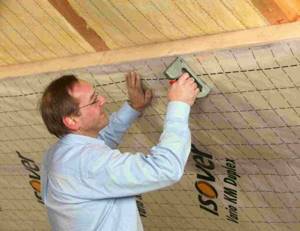
IMPORTANT: Before installing the sheathing, it is very important to treat its elements with special protective solutions, which will increase the degree of ignition of the wood and protect it from rotting.
Vapor and waterproofing... Which films are placed and where in the roof or frame wall
The main differences between insulating layers
The difference between vapor barrier and waterproofing lies in their intended purpose. Both of these layers protect the insulation, but the waterproofing layer does this from the outside, and the vapor barrier layer prevents the penetration of steam and moisture from the inside.
A vapor barrier is different in that it does not allow anything to pass through, while a waterproofing film has microscopic holes on the surface that allow warm air to leak from inside. This is the external difference between the films.
Installation of layers
The installation of films is also different; waterproofing is carried out according to the following rules:
- The film is laid out in two ways: parallel or perpendicular to the roofing frame, consisting of slats.
- It is mounted with an overlap of at least 10 centimeters.
- Special counter rails are used for fastening.
- Do not overstretch the waterproofing film.
- The fastening of the canvases can be done using tape.
Laying the vapor barrier layer begins only after the installation of thermal insulation is completed. This should be done according to the following rules:
- Any direction of installation.
- Fastening is done using slats, the distance between which should be no more than 50 cm.
- The overlap of the canvases is 10 cm.
- You can use a construction stapler to secure the film.
If you follow all the rules for installing vapor barrier and waterproofing layers, the insulation will be reliably protected. This will allow you to significantly save on heating, and will also protect the house from dampness and mold, and from destruction.
If you accidentally mix up the materials used to create layers of vapor and waterproofing, this will lead to destruction of the insulation. As a result, it will be inevitable to dismantle the entire roofing pie with a complete replacement of all three layers.
Differences in the installation of hydro- and vapor barriers
Given the difference in the structure and properties of these materials, they should be secured in different ways. To avoid mistakes, it is recommended to watch the video: insulation, waterproofing, vapor barrier - these are 3 layers of a properly equipped thermal insulation “pie”. All installation options should be considered:
- Roof. First of all, moisture protection is attached to the rafters. The waterproofing strips are laid overlapping. This increases the reliability of the coating. In addition, the waterproofing is fixed using construction tape. The vapor barrier is laid last. The principle of its fastening is similar to waterproofing: the strips are laid overlapping and secured with tape.
- External insulation. Waterproofing is installed on the street side after installing thermal insulation. In this case, a vapor barrier is not always laid.
- Internal insulation. Waterproofing is laid on top of thermal insulation in rooms such as bathrooms and kitchens. For example, if insulation is installed on a concrete floor, first the moisture barrier is attached to the ceiling, then the thermal insulation is fixed, and on the side of the room it is covered with a vapor barrier.
When installing the foundation there is no need to use both materials. Enough moisture protection. It must be remembered that the thermal insulation “pie” will suffer first of all if you lay the vapor or waterproofing membrane on the wrong side. In rooms where the roof or ceiling is protected by a vapor barrier, it is recommended to install a ventilation system, since a significant part of the vapor will be retained in the room in the form of moisture.
Installation of vapor barrier on different surfaces
Vapor barriers can be installed on different surfaces.
For example, for the floor. In this case, the material is placed inside out against the floor beams. Vice versa for the ceiling. The film is unrolled and installed with the rough side inward.
Can be installed on walls. In this case, the following rules apply:
- you need to unroll the film on the wall and secure it with staples,
- vapor barrier sheets must overlap 100-200 mm,
- Excessive tension should be avoided,
- it is necessary to provide space for ventilation,
- as in the roofing version, all joints must be taped with single-/double-sided tape to ensure complete sealing.
When installing a vapor barrier on wooden structures, the wood must be pre-treated with an antiseptic.
Important! Installation should not be carried out in wet or rainy weather. The vapor barrier material must be dry.
Most often, the manufacturer provides instructions for proper installation along with the material, and these instructions should be used. Rolls should be stored on pallets at a distance from heating devices, indoors or under a canopy. No more than 25 rolls can be stored on one pallet. Rolls are also transported on pallets in closed vehicles.
